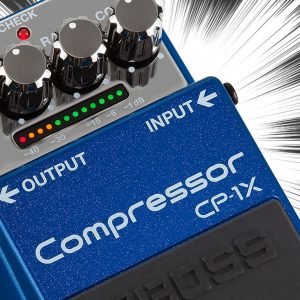Okay, this sounds like a Groucho Marx gag, but… “I love a good delay pedal. And the Boss Tera Echo is nothing like a good delay pedal.” I know, I know, but hear me out: the TE-2 Tera Echo doesn’t claim to be a delay pedal in the traditional sense. It’s not going to usurp Boss’s much-loved DD series of delay stompboxes, for instance. I say this because in all the online chatter I’ve seen about this pedal, the general view is “Oh, another Boss delay pedal? Cool …I like Boss delay pedals,” without any deeper understanding of what this pedal is designed to do. But this thing really goes beyond traditional delay, to the point of avoiding it all together. Don’t think of it as ‘another cool Boss delay,’ but rather as ‘another cool Boss pedal innovation.’
by Peter Hodgson
So if it’s not a traditional delay, what is it? Well, aside from being the hundredth boss compact effect to be released, it uses Roland’s innovative Multi-Dimensional Processing (MDP), technology which analyses audio signals in many dimensions and applies ideal effects to each. In other words, it tracks changes to the input signal in realtime and applies processing accordingly. It’s used in a few other new Boss pedals too: the MO-2 Multi Overtone uses the guitar’s harmonic characteristics to build unique rich sounds that enhance the normal tone, while the DA-2 Adaptive Distortion is designed to give you the perfect distortion tone and texture no matter where you are on the neck, morphing and adapting as you move around rather than pegging your signal through a static set of processing steps. In the Tera Echo’s case, the MDP is designed to give you an incredibly deep and spacious echo effect to enhance the straight guitar tone without overwhelming it.
The controls include knobs for Effect Level, Tone, Feedback and Spread Time, and if you hold down the pedal switch you’ll engage the Freeze function, which lets you hold the current effect sound and then play over it. Kind of like creating a static loop or an on-the-fly keyboard pad. It has stereo inputs and outputs (although you can of course use it in fully mono mode or use a mono input source and stereo output). It’s powered by a 9V DC adaptor, and it’s kitted out in the same casing that has served Boss pedals perfectly well since the 1977 introduction of the OD-1 Over Drive.
So, with all that in mind, exactly what kind of sound does the Tera Echo make? Well, think of it as an especially beautiful-sounding modulated delay that morphs in intensity with the strength of your picking or the complexity of your arpeggios and what have you. You can set the Spread Time nice and short with a low Tone setting to add a beautiful but hard-to-pin-down thickening of your guitar tone. You can go for a medium Spread Time to create more of an ambient effect which will percolate underneath your playing. Or you can crank up the Spread Time to create dreamy, loop-like soundscapes which you can use to either back up your playing as you move from note to note and chord to chord, or engage the Freeze mode to hold onto a moment in time to solo over. The input reflexivity is certainly one of the Tera Echo’s biggest strengths, but don’t overlook the power of the Tone control. You can use it to fade the effect back into the distance or to really push it out to the front. And extreme treble settings introduce an almost sitar-like resonance behind your original note.
The Tera Echo is best thought of as a special effect for use at particular musical moments or for particular songs, rather than as a ‘leave on all the time’ delay. And it’s such a useful effect that you’ll find applications for it in all sorts of genres. It feels tailor-made for indie styles, but it’s also amazing for progressive rock/metal clean tones and to add a wall of ethereal shimmer to huge Devin Townsend-esque Open C metal riffs or for djent clean tones. It seems most at home in an effect loop, where it can truly show off the clarity of the straight guitar signal in juxtaposition with the haunting effected one, but it can be pretty useful through an amp’s front end too for a little earthier a tone. It may not usurp Boss’s venerable DD line of delays, but it augments them in a way that no other pedal can.
Related Article
Echoes in Time: The History of BOSS Delay Pedals
Related Product
- TE-2
- Next-generation BOSS compact pedal with innovative Multi-Dimensional Processing and spacious echo and ambience effects.








